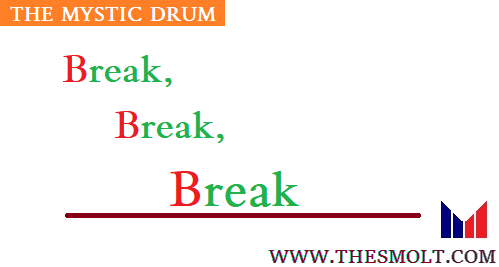Break Break Break
Ans. Break Break Break Lord Tennyson is perhaps the greatest and most representative poet of the Victorian age. His long life spans the best half-century of the Victorian era.
He had already started writing poetry when Keats and Shelley were in their last few years of intense creation. He inherited the romantic legacy, but in his basic work, it is transmuted into great and original poetry.
Tennyson was a master craftsman. According tommeI for Evans, Tennyson had the “most perfect control of the sounds of English, an impeccable ear and a consummate choice and taste in words.

Indeed, his early lyrics seem to exist only to weave patterns of words, like tapestries, or to create tunes and verbal rhythms, delicate and faultless”.
Analysis of tears idle tears by Lord Tennyson (Read Here)
“Break, Break, Break’, is a brief lyric expressing an elegiac sentiment over the death of Arthur Hallam, Tennyson’s beloved friend, who died at an early age, in 1833.
Tennyson break break break
It was composed early one morning in a Lincolnshire lane, according to the poet. The poem was first published in poems(1842). It is one of the finest elegiac Poems in English.
This brief lyric presents the elegiac sentiments of the poet over the h of his beloved friend, Arthur Hallam. It presents the poet’s feeling of deep grief against the background of the tranquil yet turbulent seascape.
Perhaps, the poet is sitting on the seashore sad with the memories of his lost friend Hallam. The memories are welling up, just as the waves of the sea are crashing against the cold crags.
The whole scene is full of moment mirth and “stately’ tranquillity. The fisherman’s children play playing on the shore. The sailor’s lad is singing in his boat on the bay. It is indeed a tranquil seascape.

Break of day in the Trenches (Read)
Alfred lord Tennyson break break break
Against the background of tranquillity, there is a turmoil of grief in the poet’s heart, unseen, unheard. The crashing of sea waves on the cold crags of the shore is contrasted with the poet’s heart which finds no release for its burden of grief.
In the third stanza, the contrast is between the “stately ships’ sailing to their quiet harbors under the hill and the memories of “the touch of a vanished hand.
And the sound of a voice that is still!’ Again visible tranquillity is contrasted with invisible pangs of sorrow in the poet’s heart.
“Break, Break, Break’ is one of the finest lyrics in English poetry. It has a well-defined pattern, with the recurrence of the image of the breaking waves with which the poem began.
The images are simple, vivid, and carefully chosen. The music is superb. It is indeed one of the finest lyrics ever written.
Read more from Mystic Drum (click)
